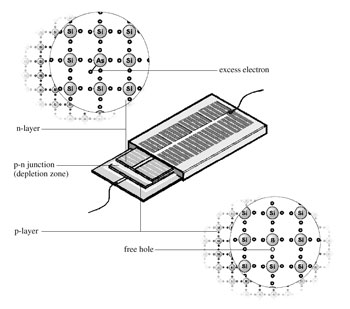| |
| Solar
Cell systems convert sunlight
directly into electrical
energy. |
|
|
|
 The
backbone of this technology are semiconducting
materials such as silicon. The
backbone of this technology are semiconducting
materials such as silicon.
A typical solar cell consists of two differently
doped semiconductors. Doping is the controlled
introduction of impurities into the host material.
Starting out with a pure semiconductor crystal
(say, silicon) this is achieved by substituting
some of the atoms in the crystal lattice with
elements that have one more or less valence
electron than the host material (valence electrons
are the electrons that determine the chemical
behavior of a material, they are located in
the outermost orbital shell of the atom).
Semiconducting elements have four valence
electrons all of which are used for bonding
in the crystal lattice. If the doping material
has five valence electron there will be one
additional, loosely bound electron per dopant
atom. These 'free' atoms can move about easily
in the lattice and are responsible for an
increase in conductivity. Since they have
a negative charge the material doped in this
way is called an n-type semiconductor. If,
on the other hand, the doping material has
only three valence electrons the lattice structure
will be deficient of electrons and there will
be one hole, or positive charge, per dopant
atom. Similar to the free electrons above
the holes can easily move about in the lattice,
again causing an increase in conductivity.
Since in this case the free charge carriers
are positive this kind of semiconductor is
said to be of p-type.
When a p-type semiconductor is joined to an
n-type semiconductor, a p-n junction is created.
While each side by itself is electrically
neutral (there are as many electrons as there
are protons) this different for certain areas
of the combined configuration. The concentration
differences of holes and free electrons between
the n- and p-regions produce a diffusion current:
electrons flow from the n-side and fill holes
on the p-side. This creates a region that
is almost devoid of free charge carriers (i.e.
free electrons or holes) and is therefore
called the depletion zone. In the depletion
zero these is a net positive charge on the
n-side and a net negative charge on the p-side
resulting in an electric field that opposes
a further flow of electron. The more electrons
move from the n-to the p-side the stronger
the opposing field will be and eventually
an equilibrium will be reached in which no
further electrons are able to move against
the electric field. The potential difference
of the equilibrium electric field is called
the diffusion voltage. It cannot be used externally.
However, when light hits the solar cell the
equilibrium conditions are disturbed and the
so-called inner photo effect creates additional
charge carriers that are free to move in the
electric field of the depletion zone.
Holes move towards the p-region and electrons
towards the n-region, thus creating an external
voltage (no-load voltage) at the cell. The
no-load voltage of a solar cell is material
dependent and does not depend on the cell's
surface area. A Silicon solar cell has a no-load
voltage of about 0.5V. Higher voltage can
be obtained by connecting individual cell
in series.
The Current delivered by a solar cell is proportional
to the intensity of the incoming light. Higher
currents can be achieved by connecting cells
in parallel.
The power of a solar cell depends on the connected
electrical load. The maximum power point (MPP)
can easily be determined from the power-voltage
characteristic of the cell.
The efficiency of a solar cell is temperature
dependent. It will decrease with increasing
temperature.
Source: h-tec GmbH © h-tec GmbH
|
|
 |
|
